Edoardo Ponti
Training Plug-n-Play Knowledge Modules with Deep Context Distillation
Mar 11, 2025Abstract:Dynamically integrating new or rapidly evolving information after (Large) Language Model pre-training remains challenging, particularly in low-data scenarios or when dealing with private and specialized documents. In-context learning and retrieval-augmented generation (RAG) face limitations, including their high inference costs and their inability to capture global document information. In this paper, we propose a way of modularizing knowledge by training document-level Knowledge Modules (KMs). KMs are lightweight components implemented as parameter-efficient LoRA modules, which are trained to store information about new documents and can be easily plugged into models on demand. We show that next-token prediction performs poorly as the training objective for KMs. We instead propose Deep Context Distillation: we learn KMs parameters such as to simulate hidden states and logits of a teacher that takes the document in context. Our method outperforms standard next-token prediction and pre-instruction training techniques, across two datasets. Finally, we highlight synergies between KMs and retrieval-augmented generation.
A Grounded Typology of Word Classes
Dec 13, 2024Abstract:We propose a grounded approach to meaning in language typology. We treat data from perceptual modalities, such as images, as a language-agnostic representation of meaning. Hence, we can quantify the function--form relationship between images and captions across languages. Inspired by information theory, we define "groundedness", an empirical measure of contextual semantic contentfulness (formulated as a difference in surprisal) which can be computed with multilingual multimodal language models. As a proof of concept, we apply this measure to the typology of word classes. Our measure captures the contentfulness asymmetry between functional (grammatical) and lexical (content) classes across languages, but contradicts the view that functional classes do not convey content. Moreover, we find universal trends in the hierarchy of groundedness (e.g., nouns > adjectives > verbs), and show that our measure partly correlates with psycholinguistic concreteness norms in English. We release a dataset of groundedness scores for 30 languages. Our results suggest that the grounded typology approach can provide quantitative evidence about semantic function in language.
MoE-CAP: Cost-Accuracy-Performance Benchmarking for Mixture-of-Experts Systems
Dec 10, 2024Abstract:The sparse Mixture-of-Experts (MoE) architecture is increasingly favored for scaling Large Language Models (LLMs) efficiently; however, MoE systems rely on heterogeneous compute and memory resources. These factors collectively influence the system's Cost, Accuracy, and Performance (CAP), creating a challenging trade-off. Current benchmarks often fail to provide precise estimates of these effects, complicating practical considerations for deploying MoE systems. To bridge this gap, we introduce MoE-CAP, a benchmark specifically designed to evaluate MoE systems. Our findings highlight the difficulty of achieving an optimal balance of cost, accuracy, and performance with existing hardware capabilities. MoE systems often necessitate compromises on one factor to optimize the other two, a dynamic we term the MoE-CAP trade-off. To identify the best trade-off, we propose novel performance evaluation metrics - Sparse Memory Bandwidth Utilization (S-MBU) and Sparse Model FLOPS Utilization (S-MFU) - and develop cost models that account for the heterogeneous compute and memory hardware integral to MoE systems. This benchmark is publicly available on HuggingFace: https://huggingface.co/spaces/sparse-generative-ai/open-moe-llm-leaderboard.
Mixtures of In-Context Learners
Nov 05, 2024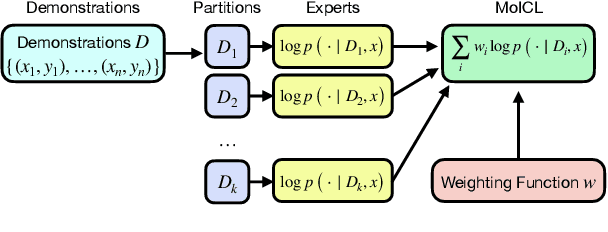
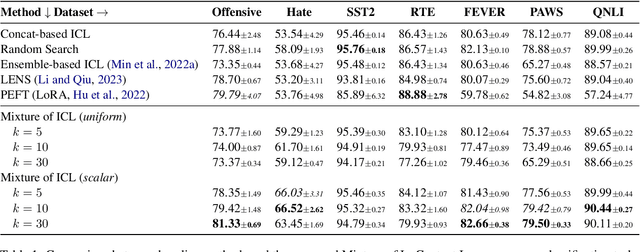
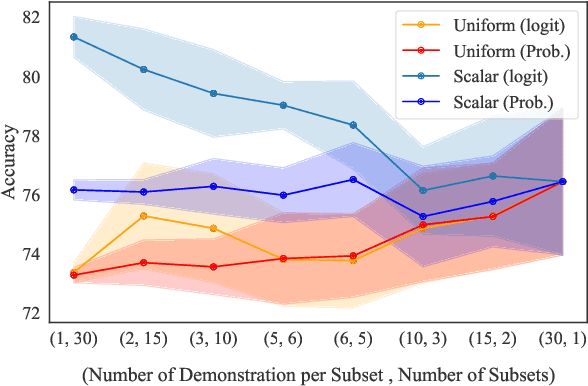
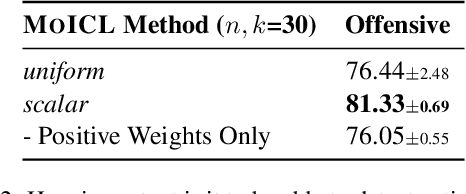
Abstract:In-context learning (ICL) adapts LLMs by providing demonstrations without fine-tuning the model parameters; however, it does not differentiate between demonstrations and quadratically increases the complexity of Transformer LLMs, exhausting the memory. As a solution, we propose Mixtures of In-Context Learners (MoICL), a novel approach to treat subsets of demonstrations as experts and learn a weighting function to merge their output distributions based on a training set. In our experiments, we show performance improvements on 5 out of 7 classification datasets compared to a set of strong baselines (up to +13\% compared to ICL and LENS). Moreover, we enhance the Pareto frontier of ICL by reducing the inference time needed to achieve the same performance with fewer demonstrations. Finally, MoICL is more robust to out-of-domain (up to +11\%), imbalanced (up to +49\%), or noisy demonstrations (up to +38\%) or can filter these out from datasets. Overall, MoICL is a more expressive approach to learning from demonstrations without exhausting the context window or memory.
Multi-Head Adapter Routing for Data-Efficient Fine-Tuning
Nov 07, 2022Abstract:Parameter-efficient fine-tuning (PEFT) methods can adapt large language models to downstream tasks by training a small amount of newly added parameters. In multi-task settings, PEFT adapters typically train on each task independently, inhibiting transfer across tasks, or on the concatenation of all tasks, which can lead to negative interference. To address this, Polytropon (Ponti et al.) jointly learns an inventory of PEFT adapters and a routing function to share variable-size sets of adapters across tasks. Subsequently, adapters can be re-combined and fine-tuned on novel tasks even with limited data. In this paper, we investigate to what extent the ability to control which adapters are active for each task leads to sample-efficient generalization. Thus, we propose less expressive variants where we perform weighted averaging of the adapters before few-shot adaptation (Poly-mu) instead of learning a routing function. Moreover, we introduce more expressive variants where finer-grained task-adapter allocation is learned through a multi-head routing function (Poly-S). We test these variants on three separate benchmarks for multi-task learning. We find that Poly-S achieves gains on all three (up to 5.3 points on average) over strong baselines, while incurring a negligible additional cost in parameter count. In particular, we find that instruction tuning, where models are fully fine-tuned on natural language instructions for each task, is inferior to modular methods such as Polytropon and our proposed variants.
Same Neurons, Different Languages: Probing Morphosyntax in Multilingual Pre-trained Models
May 08, 2022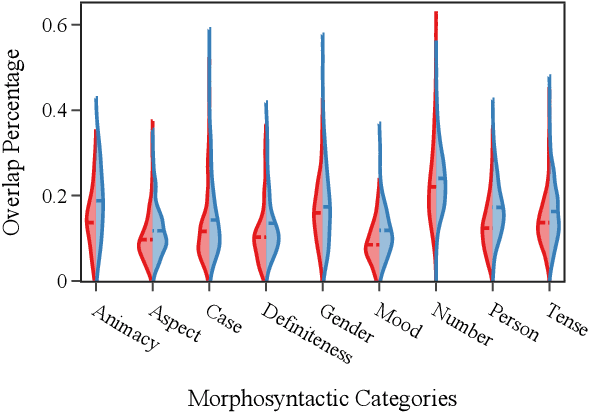
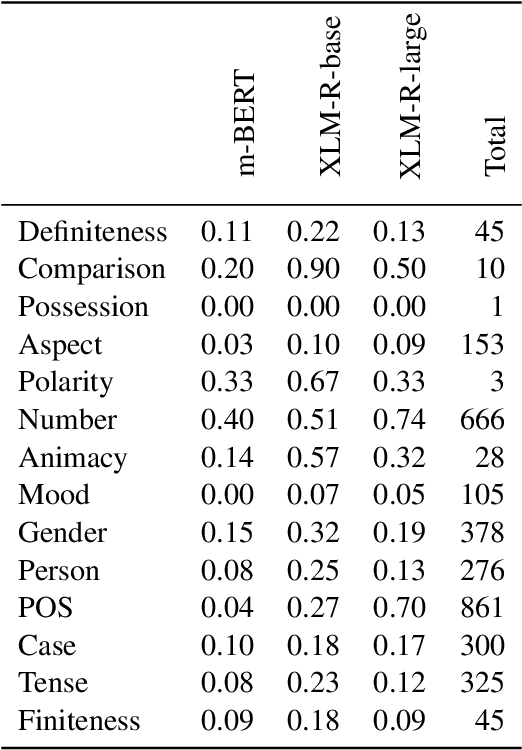
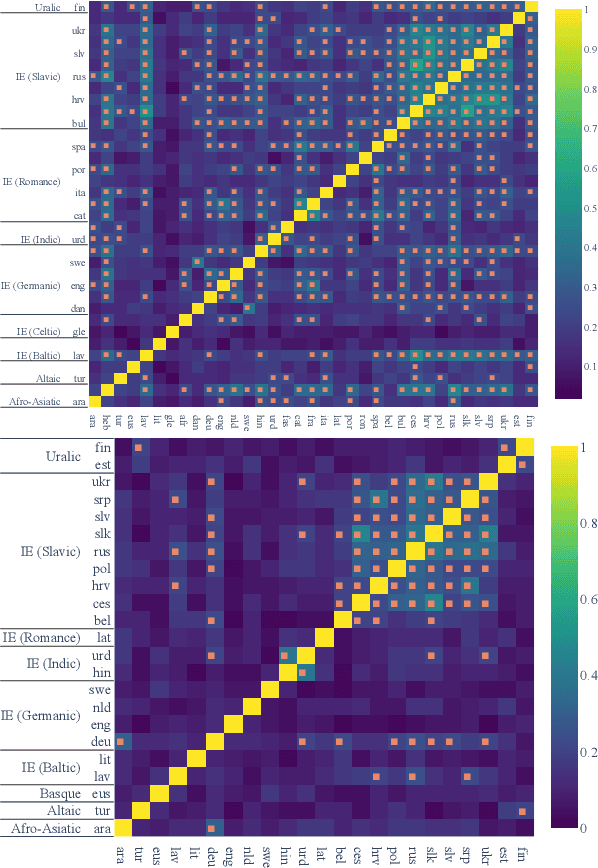
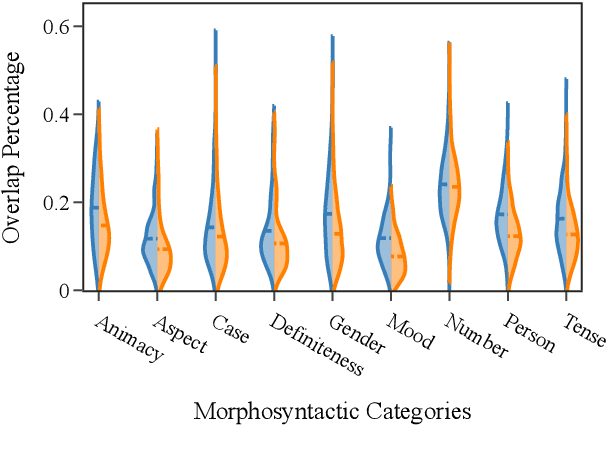
Abstract:The success of multilingual pre-trained models is underpinned by their ability to learn representations shared by multiple languages even in absence of any explicit supervision. However, it remains unclear how these models learn to generalise across languages. In this work, we conjecture that multilingual pre-trained models can derive language-universal abstractions about grammar. In particular, we investigate whether morphosyntactic information is encoded in the same subset of neurons in different languages. We conduct the first large-scale empirical study over 43 languages and 14 morphosyntactic categories with a state-of-the-art neuron-level probe. Our findings show that the cross-lingual overlap between neurons is significant, but its extent may vary across categories and depends on language proximity and pre-training data size.
Image Retrieval from Contextual Descriptions
Mar 29, 2022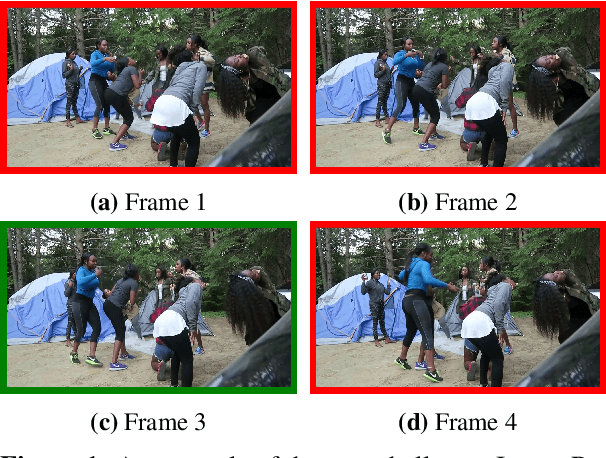
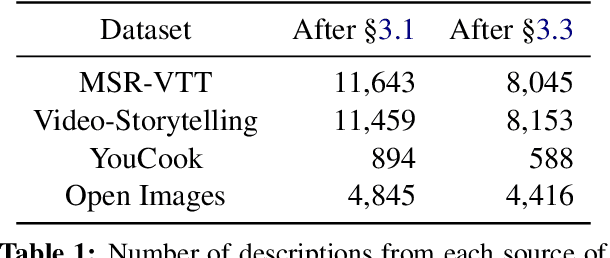
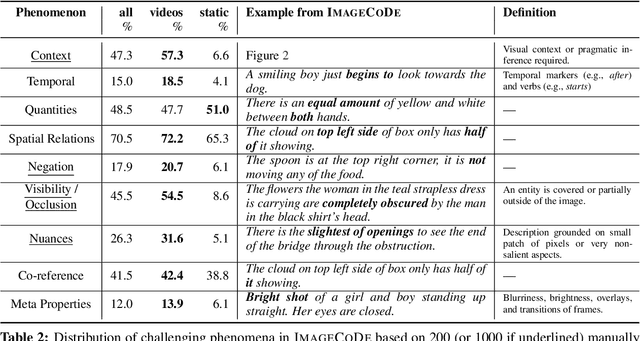
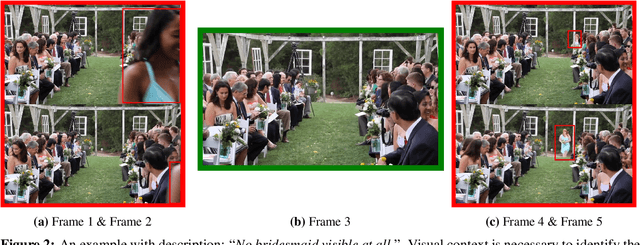
Abstract:The ability to integrate context, including perceptual and temporal cues, plays a pivotal role in grounding the meaning of a linguistic utterance. In order to measure to what extent current vision-and-language models master this ability, we devise a new multimodal challenge, Image Retrieval from Contextual Descriptions (ImageCoDe). In particular, models are tasked with retrieving the correct image from a set of 10 minimally contrastive candidates based on a contextual description. As such, each description contains only the details that help distinguish between images. Because of this, descriptions tend to be complex in terms of syntax and discourse and require drawing pragmatic inferences. Images are sourced from both static pictures and video frames. We benchmark several state-of-the-art models, including both cross-encoders such as ViLBERT and bi-encoders such as CLIP, on ImageCoDe. Our results reveal that these models dramatically lag behind human performance: the best variant achieves an accuracy of 20.9 on video frames and 59.4 on static pictures, compared with 90.8 in humans. Furthermore, we experiment with new model variants that are better equipped to incorporate visual and temporal context into their representations, which achieve modest gains. Our hope is that ImageCoDE will foster progress in grounded language understanding by encouraging models to focus on fine-grained visual differences.
SIGTYP 2021 Shared Task: Robust Spoken Language Identification
Jun 07, 2021



Abstract:While language identification is a fundamental speech and language processing task, for many languages and language families it remains a challenging task. For many low-resource and endangered languages this is in part due to resource availability: where larger datasets exist, they may be single-speaker or have different domains than desired application scenarios, demanding a need for domain and speaker-invariant language identification systems. This year's shared task on robust spoken language identification sought to investigate just this scenario: systems were to be trained on largely single-speaker speech from one domain, but evaluated on data in other domains recorded from speakers under different recording circumstances, mimicking realistic low-resource scenarios. We see that domain and speaker mismatch proves very challenging for current methods which can perform above 95% accuracy in-domain, which domain adaptation can address to some degree, but that these conditions merit further investigation to make spoken language identification accessible in many scenarios.
SIGMORPHON 2020 Shared Task 0: Typologically Diverse Morphological Inflection
Jul 14, 2020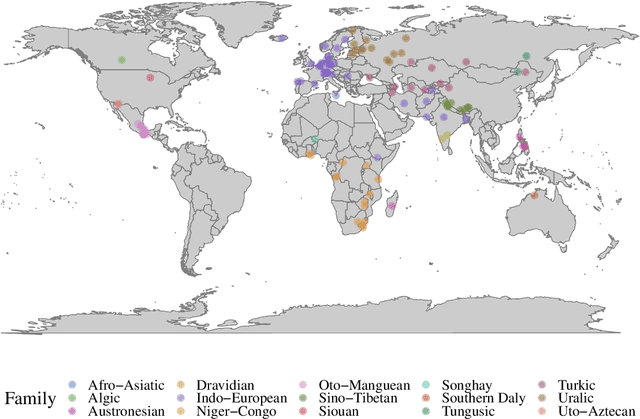
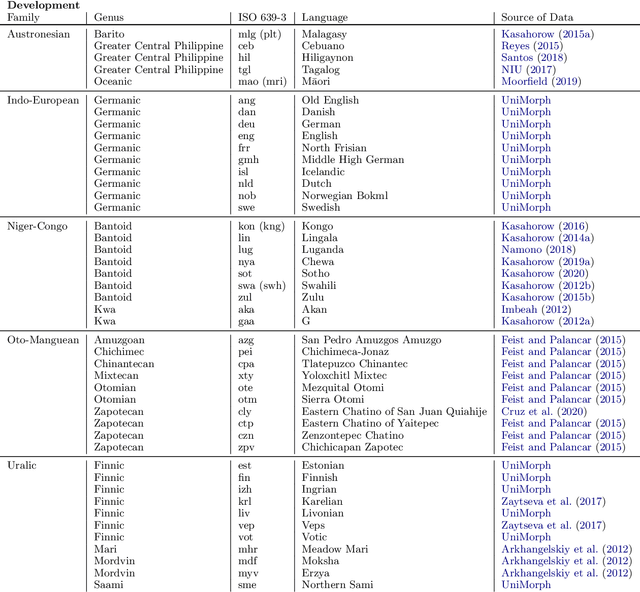
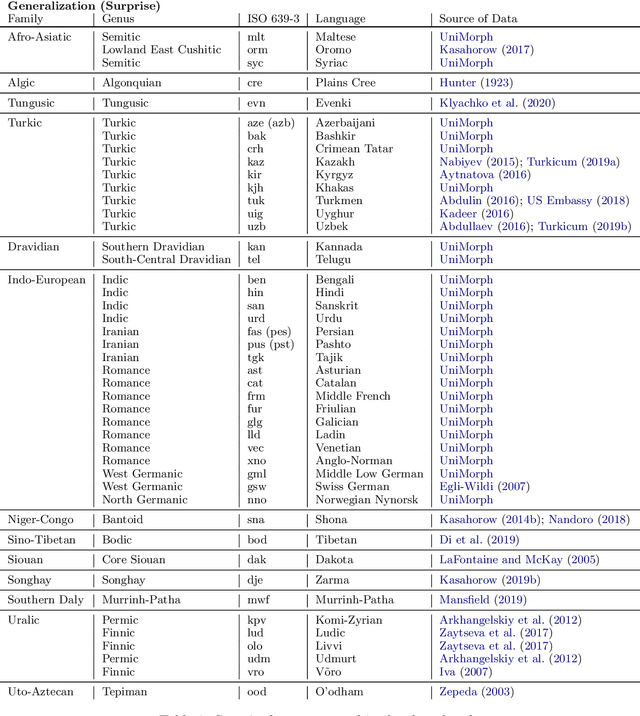
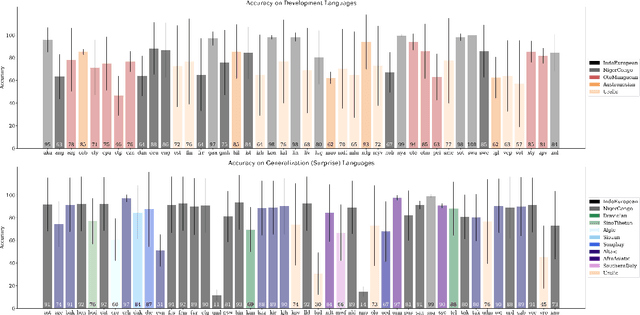
Abstract:A broad goal in natural language processing (NLP) is to develop a system that has the capacity to process any natural language. Most systems, however, are developed using data from just one language such as English. The SIGMORPHON 2020 shared task on morphological reinflection aims to investigate systems' ability to generalize across typologically distinct languages, many of which are low resource. Systems were developed using data from 45 languages and just 5 language families, fine-tuned with data from an additional 45 languages and 10 language families (13 in total), and evaluated on all 90 languages. A total of 22 systems (19 neural) from 10 teams were submitted to the task. All four winning systems were neural (two monolingual transformers and two massively multilingual RNN-based models with gated attention). Most teams demonstrate utility of data hallucination and augmentation, ensembles, and multilingual training for low-resource languages. Non-neural learners and manually designed grammars showed competitive and even superior performance on some languages (such as Ingrian, Tajik, Tagalog, Zarma, Lingala), especially with very limited data. Some language families (Afro-Asiatic, Niger-Congo, Turkic) were relatively easy for most systems and achieved over 90% mean accuracy while others were more challenging.
 Add to Chrome
Add to Chrome Add to Firefox
Add to Firefox Add to Edge
Add to Edge